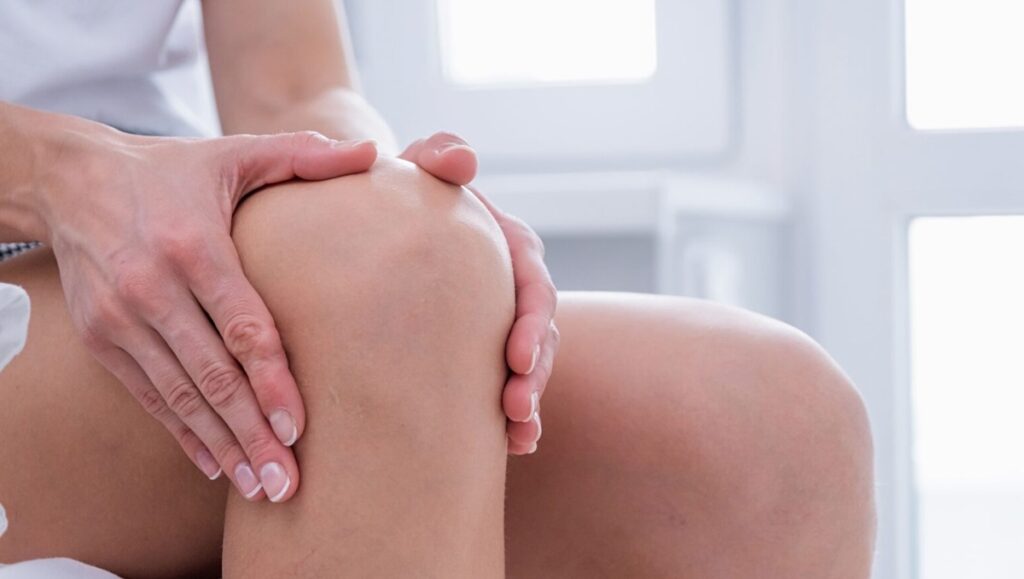
Non-Surgical Blog
Swollen Knee Without Pain: Causes & Treatment Guide
May 4, 2025

- Experiencing knee swelling without accompanying pain can be perplexing.
- Various factors, ranging from injuries to chronic conditions, can lead to painless knee swelling.
- While not all instances are cause for alarm, it’s crucial to recognize potential red flags that might indicate a serious underlying problem.
- Diagnosing the root cause often involves a combination of physical examinations and medical tests.
- Treatment approaches for painless knee swelling vary depending on the underlying cause and may involve home remedies, medical interventions, or both.
A swollen knee is a common ailment that can often signal an issue within the knee joint. While knee swelling commonly occurs alongside pain, there are situations where you might experience swelling without any discomfort. This can be confusing and leave you wondering if you need medical attention.
Understanding the potential reasons behind painless knee swelling is crucial for determining the appropriate course of action.
Understanding Swollen Knees Without Pain
A swollen knee, medically termed as knee effusion, occurs when there’s an abnormal accumulation of fluid within or around the knee joint. This can happen due to various reasons, such as an injury, chronic health condition, or infection. The presence of pain often serves as an indicator of the underlying issue and its severity.
However, swelling in the knee doesn’t always translate to immediate or noticeable pain. This can sometimes make diagnosing the cause a bit tricky. Recognizing that painless knee swelling can still stem from potentially serious conditions is vital to ensure you receive the appropriate medical care.
Overview of Knee Swelling
Knee effusion, or the buildup of excess fluid in or around the knee joint, is a common symptom across a range of conditions. This excess fluid can be a result of inflammation, injury, or even an underlying medical condition. When we talk about “water on the knee,” we are essentially referring to knee effusion.
Normally, a certain amount of fluid lubricates the knee joint for smooth movement. However, when the body senses damage or irritation, it may produce extra fluid as a protective mechanism, leading to noticeable swelling. This is the body’s natural response to try and cushion and protect the area.
However, this buildup of fluid can sometimes interfere with normal joint function, leading to stiffness, reduced range of motion, and, in some cases, pain. The presence and severity of pain, along with other symptoms, often provide clues about the underlying cause of the swelling.
Differentiating Between Painful and Painless Swelling
Understanding the characteristics of your knee swelling is important. For instance, is it painful or painless? While both types can signal a potential problem, the presence or absence of pain can be a helpful clue.
Painful knee swelling often points to an acute injury or inflammatory condition. The pain is triggered by the irritation or compression of nerves in and around the affected area. The severity of pain generally correlates with the degree of inflammation or damage, often impacting the range of motion as well.
Painless swelling, on the other hand, may not always stem from a direct injury. It can sometimes be a symptom of a chronic condition or a delayed reaction to an old injury. This is not to say that painless knee swelling is harmless – it can still be a sign of a serious condition, and addressing it proactively is essential.
Common Causes of a Swollen Knee Without Pain
Knee swelling without pain can be attributed to a range of factors, from injuries that don’t trigger immediate discomfort to underlying chronic conditions. Understanding the distinction between these common causes can provide valuable insights into the nature and potential seriousness of your condition.
Identifying the specific reason behind your swollen knee is crucial for determining the appropriate treatment approach. If you’re unsure about the cause of your knee swelling, it’s always best to consult a medical professional for a comprehensive evaluation.
Injuries That Might Not Cause Immediate Pain
It’s common to associate knee injuries with pain; however, not all knee injury symptoms manifest immediately. There are situations where you may experience a sudden injury or even blunt force trauma to the knee, and the pain might take a while to surface.
For instance, certain ligament injuries, such as a minor sprain, might not be immediately painful, with swelling being the primary initial symptom. Similarly, injuries to the meniscus, which acts as a shock absorber in the knee joint, can also lead to delayed pain. In these cases, the swelling serves as the body’s natural response to the trauma.
It’s important to remember that the absence of immediate pain doesn’t necessarily equate to a less serious knee injury. Even in cases of delayed pain, seeking medical attention is crucial for a proper diagnosis and to prevent potential long-term complications.
Chronic Conditions Leading to Swelling
Apart from acute injuries, chronic conditions like osteoarthritis and rheumatoid arthritis are common culprits behind knee swelling, often without any significant pain in the initial stages. These types of arthritis involve chronic inflammation of the joint, leading to the slow breakdown of cartilage and, subsequently, swelling.
As the condition progresses, the lack of cartilage can cause bones to rub against each other, leading to pain. However, in the early stages, the swelling might be the only noticeable sign. This chronic swelling, if left unaddressed, can further contribute to joint degeneration and potentially hasten the progression of the condition.
If you notice persistent or recurrent knee swelling without any clear cause, it’s crucial to consult Chattanooga Non-Surgical Orthopedics to rule out any underlying chronic conditions. Early diagnosis and management of these conditions are key to slowing down their progression, managing pain, and preserving joint health.
Fluid Build-Up Explained
When the knee joint experiences an injury or is affected by certain medical conditions, the natural response of our body is to send inflammatory cells to the affected area. These cells release chemicals that cause fluid to build up in the joint, resulting in what we perceive as swelling.
Here’s a simplified breakdown of how this buildup of fluid occurs:
- Injury or Irritation: This could be from a sudden impact, overuse, or underlying conditions like arthritis.
- Inflammatory Response: The body sends white blood cells to the affected knee to initiate the healing process.
- Fluid Accumulation: This inflammatory response leads to an increased production of synovial fluid, which serves to lubricate the joint and aid healing. However, in this case, the fluid production exceeds the normal amount, causing the joint to swell.
Medical Conditions Associated with Painless Knee Swelling
Several medical conditions can contribute to painless knee swelling. Some common culprits include osteoarthritis, rheumatoid arthritis, and bursitis. Each condition has unique characteristics and triggers, and understanding these differences can be helpful for both diagnosis and treatment.
If you experience persistent knee swelling, especially without a known cause, it’s vital to consult Chattanooga Non-Surgical Orthopedics. We can accurately diagnose the underlying condition and recommend a personalized treatment plan tailored to your specific needs.
Osteoarthritis and Its Impact on the Knee
Osteoarthritis is a degenerative joint disease that primarily affects cartilage – the protective tissue that cushions the ends of bones within the joints. In the case of knee osteoarthritis, the cartilage within the knee joint gradually breaks down, leading to pain, stiffness, and swelling.
The cartilage degradation in osteoarthritis triggers an inflammatory response in the joint, contributing to the buildup of fluid and subsequent swelling. Initially, the swelling might not always be accompanied by significant pain, especially in the early stages of the condition.
As osteoarthritis progresses, the lack of cartilage can cause bones to rub against each other, resulting in pain, inflammation, and further joint tissue damage. This can significantly affect mobility and quality of life. Therefore, addressing knee swelling, even if painless, is crucial to potentially slow the progression of osteoarthritis and manage symptoms effectively.
The Role of Rheumatoid Arthritis
Rheumatoid arthritis is a chronic autoimmune disease where the body’s immune system mistakenly attacks its own healthy tissues, particularly the delicate lining of the joints (synovium). In the case of the knee, this autoimmune response leads to inflammation, pain, stiffness, and swelling.
Unlike osteoarthritis, which generally affects people later in life, rheumatoid arthritis can develop at any age. The symptoms often start gradually and can fluctuate in intensity. While pain, stiffness, and swelling are common symptoms of rheumatoid arthritis, it’s worth noting that some individuals may experience periods of remission where symptoms subside.
If left untreated, rheumatoid arthritis can cause permanent damage to the joints, leading to significant disability. However, with early diagnosis and appropriate treatment, including medications, physical therapy, and lifestyle modifications, it’s possible to manage the symptoms effectively and slow down the progression of the disease.
Identifying Bursitis as a Culprit
Bursitis, a painful condition that affects the small, fluid-filled sacs (bursae) that cushion the bones, tendons, and muscles near your joints, can also contribute to a swollen knee. In the knee, the most commonly affected bursa is the prepatellar bursa, located just in front of the kneecap. When this bursa becomes inflamed, it’s known as prepatellar bursitis, often caused by repetitive stress, kneeling for prolonged periods, or direct trauma to the knee.
Prepatellar bursitis typically presents with pain, swelling, and tenderness over the kneecap. However, in some cases, the swelling might be the more prominent symptom, with minimal or no pain. Another form of bursitis, known as septic bursitis, occurs when the inflamed knee bursa becomes infected. This condition often requires immediate medical attention as it can quickly become serious.
Recognizing the symptoms of bursitis is essential for early diagnosis and management. If you notice swelling, redness, or warmth around your knee, along with pain or difficulty moving the joint, consulting a doctor for proper evaluation and treatment is vital.
Diagnostic Approaches for Swollen Knees
Diagnosing the cause of a swollen knee, especially when it’s painless, often involves a combination of physical examination and diagnostic tests. During the examination, your Doctor Hall will evaluate your knee’s range of motion, check for tenderness, and assess the degree of swelling.
Based on your medical history, physical exam findings, and suspicion of underlying conditions, Dr. Hall might recommend further investigations, like imaging tests or blood work.
When to Seek Medical Advice
Knowing when to seek medical advice for a swollen knee is crucial, especially because not all cases necessitate immediate medical attention. For instance, if your swelling is mild, painless, and doesn’t restrict your daily activities, it might be appropriate to observe it for a few days and see if it improves on its own.
However, there are certain red flags that warrant prompt medical attention. Seek immediate medical attention if:
- You experience severe pain, redness, or warmth around the knee joint.
- You have a fever along with the knee swelling.
- The swelling is accompanied by a locking sensation in the knee.
- You are unable to bear weight on the affected leg.
In these scenarios, it’s vital to consult a healthcare provider promptly to rule out any serious conditions. Early diagnosis and intervention can significantly impact the outcome and potentially prevent long-term complications.
What to Expect During the Diagnosis Process
When you visit Chattanooga Non-Surgical Orthopedics for a swollen knee, we will first inquire about your medical history, including any recent injuries or pre-existing conditions. Next, we’ll conduct a physical exam, visually inspecting the knee for swelling, redness, or bruising, and checking for tenderness, range of motion, and stability.
Further investigations are often required to pinpoint the exact cause of the swelling. These might include:
| Test | Description |
| X-ray | Provides images of bones and can reveal fractures, arthritis, or other bone abnormalities. |
| Ultrasound | Uses sound waves to create images of soft tissues, helping visualize ligaments, tendons, and bursae. |
| Blood Work | Can detect signs of infection, inflammation, or underlying medical conditions. |
| Joint Fluid Analysis | Involves extracting a small amount (a few ml of joint fluid) from the knee joint using a needle to analyze for infection, inflammation, or crystals. |
Based on the diagnosis, your doctor will recommend the most appropriate medical treatment, which might range from conservative measures like rest and medication to minimally invasive procedures such as draining the excess fluid.
Treatment Options for Swollen Knee Without Pain
When it comes to a swollen knee without pain, the treatment approach largely depends on the underlying cause. In many cases, conservative measures like rest, ice, compression, and elevation (RICE) along with over-the-counter pain relievers are often sufficient to reduce swelling and alleviate discomfort.
However, if the swelling persists or is caused by an underlying condition like arthritis, your Dr. Hall might recommend other treatments.
Home Remedies to Reduce Swelling
If your swollen knee isn’t causing significant pain or discomfort and your doctor has ruled out any serious underlying conditions, there are several home remedies you can try to help reduce the swelling and maintain knee flexibility:
- Rest: Avoid putting excessive weight on the affected knee and engage in activities that don’t strain the joint.
- Ice Application: Applying an ice pack wrapped in a towel to the swollen area for 15-20 minutes at a time, several times a day, can help reduce inflammation and numb the area.
- Compression: Wrapping the affected knee with a compression bandage can help limit swelling. However, avoid wrapping it too tightly as it can restrict blood flow.
- Elevation: While resting, elevate your leg above heart level to help reduce swelling.
Conclusion
Swollen knee without pain can be concerning, but understanding the causes and treatment options is key. Differentiating between painless and painful swelling is crucial for proper diagnosis. Chronic conditions like osteoarthritis and rheumatoid arthritis can contribute to this issue. Seeking medical advice and exploring professional treatments are essential steps.
Home remedies and safe exercises can also help manage the swelling. If you have persistent concerns about your swollen knee, don’t hesitate to seek medical attention.
Remember, early intervention is vital for effective management of knee health. For personalized advice and guidance, feel free to get in touch with our experts.
Frequently Asked Questions
How can I differentiate between types of knee swelling?
Knee effusion often presents as a feeling of tightness or as if the knee is filled with excess fluid, similar to a water balloon. However, pinpointing the exact cause, such as specific types of arthritis or other underlying conditions, necessitates a professional medical diagnosis.
Can diet affect the swelling of my knee?
While not a direct cause, diet can play a role in managing inflammation, which often contributes to knee swelling. A balanced diet that promotes joint health might help manage symptoms, particularly in chronic conditions like arthritis.
What exercises are safe for a swollen knee without pain?
Gentle, low-impact exercises such as swimming, cycling, or walking can help maintain knee flexibility and range of motion without putting excessive stress on the joint. It’s crucial to avoid high-impact activities that could exacerbate the swelling or cause further soft tissue damage.
When should I worry about my swollen knee?
Seek medical attention if the swelling is accompanied by severe pain, redness, warmth, or difficulty bearing weight. Similarly, a suspicion of a broken bone, inability to straighten the knee, or frequent kneeling with pain should prompt a medical evaluation to rule out a serious injury.
Can a swollen knee without pain still be a sign of something serious?
Yes, painless swelling in the knee shouldn’t be ignored. While not always indicative of a serious condition, it could be a sign of an underlying condition requiring medical evaluation. Early diagnosis and treatment are crucial to prevent potential long-term complications.

Search our blog posts: